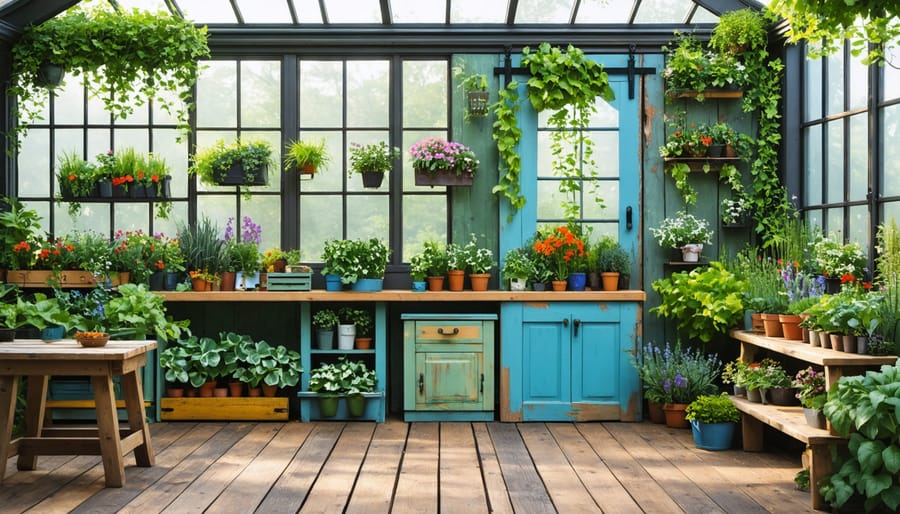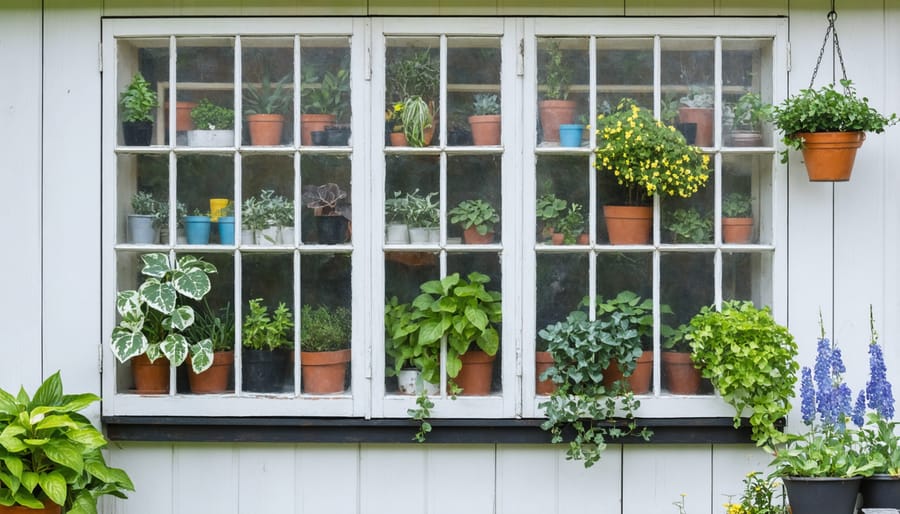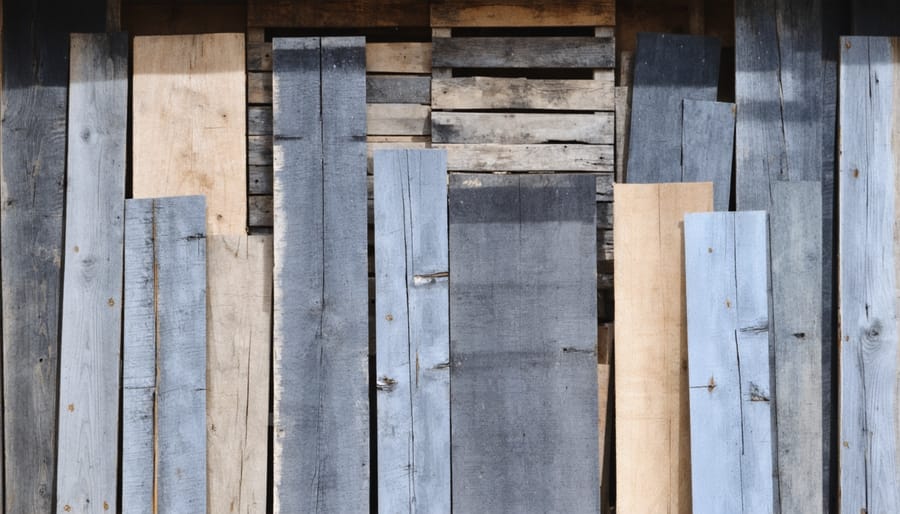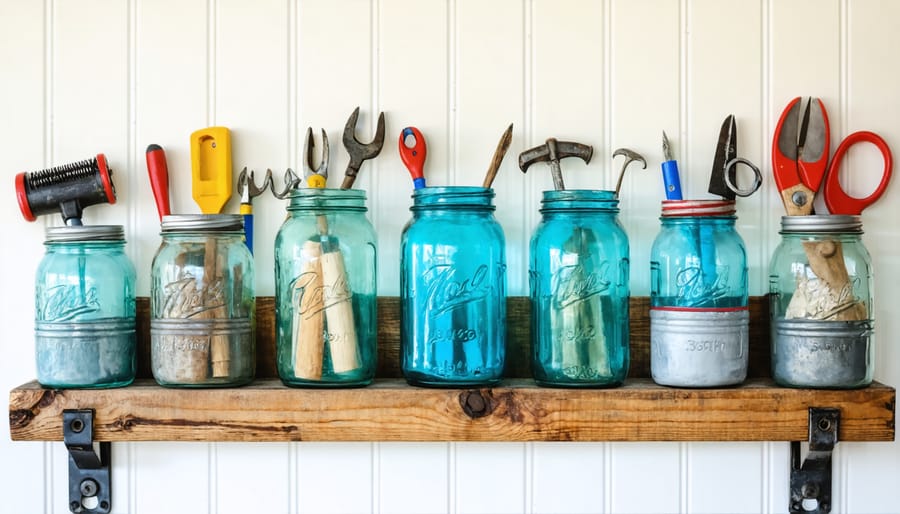Transform Your Shed with These Brilliant Upcycled Material Ideas

Transform discarded materials into stunning home features by mastering the art of upcycling. Old wooden pallets become stylish vertical gardens, vintage windows transform into greenhouse walls, and metal filing cabinets evolve into weather-resistant storage solutions. Create an eco-friendly garden sanctuary while reducing landfill waste and saving money on building materials.
Each upcycled project tells a unique story, from the weathered barn door repurposed as a rustic workbench to the industrial wire spools converted into charming outdoor tables. Modern upcycling techniques blend environmental responsibility with creative design, enabling homeowners to craft personalized spaces that reflect both style and sustainability. Whether reimagining a single window frame or tackling a complete shed transformation, these DIY projects offer endless possibilities for turning everyday cast-offs into extraordinary additions to your home.
Start small with simple container conversions, then progress to larger structural projects as your confidence grows. Local salvage yards, estate sales, and online marketplaces provide endless sources of materials waiting to be reimagined. The key lies in seeing potential where others see waste, and having the vision to transform forgotten items into functional art.
Smart Ways to Repurpose Old Windows and Doors
Window Transformations
Old windows offer incredible potential for creating beautiful and functional features in your upcycled shed project. Transform single-pane windows into charming greenhouse panels by installing them at an angle on your shed’s roof, allowing natural light to nurture indoor plants. For better airflow, consider mounting vintage windows on hinges to create custom shed ventilation solutions that add character while keeping your space comfortable.
Create a stunning accent wall by arranging multiple window frames in a grid pattern, perfect for hanging tools or displaying climbing plants. Paint the frames in coordinating colors or leave them naturally weathered for a rustic look. For added functionality, transform a large window into a fold-down workbench by adding sturdy hinges and support chains.
Don’t overlook smaller windows – they make excellent cabinet doors for built-in storage or can be repurposed into serving hatches for garden entertainment. Remember to thoroughly clean and seal old windows to protect against weather damage, and consider adding UV-protective coating if you’re using them for greenhouse purposes.

Door Revival Projects
Old doors can be transformed into stunning home features with a bit of creativity and elbow grease. Start by thoroughly cleaning your salvaged door using a gentle cleaner and steel wool to remove built-up grime. Sand down rough spots and repair any damage with wood filler before applying primer. For a vintage look, consider distressing techniques like dry brushing or using milk paint.
Transform solid doors into statement pieces by adding architectural elements like crown molding or decorative trim. Installing vintage hardware can enhance the door’s character – just ensure hinges are sturdy and properly aligned. For doors that won’t be used as entryways, consider converting them into headboards, room dividers, or unique wall art.
When installing salvaged doors, you may need to adjust the frame or trim the door slightly for a proper fit. Always check for level and plumb during installation. For outdoor projects, seal the door thoroughly with weather-resistant paint or marine-grade varnish to protect against the elements. Remember that older doors may contain lead paint, so take proper safety precautions when refinishing.

Reclaimed Wood Solutions
Pallet Wood Projects
Pallet wood offers an excellent opportunity for upcycling projects, but working with it requires the right approach. Start by carefully inspecting pallets for the HT (heat-treated) stamp, which indicates safe wood for indoor use. Avoid pallets marked with MB (methyl bromide) or those with chemical stains, as these can be hazardous.
To break down pallets effectively, begin by removing the deck boards using a pallet breaker tool or a reciprocating saw between the boards. A flat pry bar can help separate stubborn pieces without splitting the wood. Once dismantled, remove all nails and hardware, then sand the wood thoroughly to prevent splinters.
Before starting your project, let the wood acclimate indoors for at least a week to prevent warping. When planning your design, remember that pallet wood typically comes in standard sizes: deck boards are usually 3.5 inches wide, while stringers are about 3.5 inches tall.
Popular pallet wood projects include rustic shelving, coffee tables, and wall cladding. For best results, seal your finished pieces with exterior-grade polyurethane for outdoor projects or food-safe mineral oil for indoor items like kitchen organizers. Consider using wood conditioner before staining to ensure even color absorption, as pallet wood can be quite porous.
Remember to wear appropriate safety gear, including gloves and eye protection, throughout the dismantling and construction process. Working with reclaimed wood requires patience, but the unique character it adds to projects makes the effort worthwhile.
Barn Wood Applications
Reclaimed barn wood adds character and rustic charm to any shed project while promoting sustainability. When incorporating old barn wood into your shed design, start by carefully inspecting each piece for structural integrity. Look for boards that are free from extensive rot, insect damage, or warping. A wire brush can help remove loose debris while preserving the wood’s weathered patina.
Consider using barn wood for accent walls, creating a striking contrast against newer materials. The natural gray and brown tones of aged wood can transform an ordinary shed into a conversation piece. For a unique touch, install barn wood boards vertically on one wall while keeping the others horizontal, creating visual interest.
Barn wood makes excellent trim work around windows and doors, adding farmhouse appeal to your shed’s exterior. You can also craft sliding barn doors from these materials, combining functionality with authentic rustic style. For interior storage, repurpose sturdy barn wood pieces into shelving units or workbenches.
When working with barn wood, remember to:
– Remove all old nails and hardware carefully
– Sand rough edges for safety while maintaining character
– Apply a clear sealer to protect the wood without hiding its natural beauty
– Mix different wood tones for added visual interest
– Use metal brackets or supports for heavy-duty applications
Always source your barn wood responsibly, whether from local salvage yards, farm demolitions, or reclaimed wood suppliers. This ensures you’re getting quality materials while preserving pieces of architectural history.
Metal Material Magic
Corrugated Metal Solutions
Corrugated metal sheets from old roofing projects can be transformed into stunning and durable roofing solutions for your DIY projects. These versatile materials bring an industrial-chic aesthetic while providing excellent weather protection. Start by carefully removing any rust with a wire brush and treating the surface with rust converter. For a modern twist, consider painting the metal sheets in contemporary colors that complement your outdoor space.
Old metal roofing can be repurposed for accent walls, creating an eye-catching feature both inside and outside your shed. Cut panels to size and install them vertically for a sleek, modern look, or horizontally for a more traditional appearance. The natural patina that develops on metal over time adds character and charm to your project.
Don’t overlook smaller pieces of corrugated metal – they’re perfect for creating decorative planters, tool organizers, or even a rustic mailbox. Remember to smooth any sharp edges and use appropriate sealants to prevent future rust, ensuring your upcycled metal features remain beautiful and functional for years to come.
Hardware and Fixtures
Old hardware and metal fixtures can find new life in creative DIY projects. Door handles, hinges, and cabinet pulls can become unique coat hooks or jewelry organizers when mounted on reclaimed wood. Industrial-style light fixtures can be crafted from old plumbing pipes and fittings, adding character to any space while saving money and reducing waste.
Transform drawer pulls into towel holders for your bathroom, or repurpose vintage gate latches as decorative wall hooks. Metal window frames can be transformed into eye-catching photo displays or mirrors, while old keys make charming wind chimes or wall art. Even rusty tools can become statement pieces when arranged thoughtfully on a display board.
Consider updating the finish on metal pieces with spray paint or allowing them to maintain their weathered patina for an industrial look. When working with salvaged hardware, clean items thoroughly and check for sharp edges or loose components. Simple modifications like adding rubber stoppers to hooks or reinforcing mounting points can improve both safety and functionality.
Remember to collect hardware during demolition projects or visit architectural salvage yards for unique finds. These pieces often carry history and character that new items simply can’t match.
Innovative Storage Solutions
Wall Organization
Transform your wall space into an organized haven using creative upcycling solutions. Old wooden pallets can be dismantled and reconstructed into versatile tool holders, with different-sized slots perfect for hammers, screwdrivers, and other frequently used items. Paint them in your preferred color scheme to match your shed’s interior.
Mason jars, which might otherwise end up in recycling, make excellent containers for storing smaller items like nails, screws, and washers. Simply attach the jar lids to a wooden board mounted on the wall, allowing you to easily screw and unscrew the jars as needed. Label each jar clearly for quick identification.
Old guttering or PVC pipes can be cut to size and mounted horizontally to create channels for storing longer items like levels, measuring sticks, and dowels. Metal filing cabinets destined for the scrap heap can be repurposed into wall-mounted units for power tools and their accessories.
Consider transforming an old ladder into a vertical storage solution by mounting it horizontally on the wall. The rungs create natural dividers for storing garden tools, extension cords, and other lengthy items. Empty tin cans, thoroughly cleaned and painted, make perfect holders for paintbrushes and other small tools when mounted on a pegboard or directly on the wall.
For a unique twist, repurpose old kitchen utensil holders or magazine racks as wall-mounted catchalls for gardening gloves, safety equipment, and frequently used tools.

Shelving and Work Surfaces
Transform ordinary items into functional work surfaces and shelving with creative upcycling techniques. Old doors make excellent workbenches when mounted on sturdy legs from reclaimed table bases or industrial stands. Consider converting wooden pallets into adjustable wall shelves – simply disassemble, sand, and reassemble them in a grid pattern to maximize storage space while adding rustic charm.
Vintage ladders can become unique vertical storage solutions when mounted horizontally on walls, perfect for storing garden tools or creating display spaces. For a modern industrial look, repurpose metal pipes and flanges as shelf brackets, pairing them with reclaimed wood planks for custom shelving units.
Don’t overlook old cabinets and dressers – with some weatherproofing and fresh paint, they can provide excellent storage in your shed. Remove drawers from old furniture pieces to create open shelving, or use the drawers themselves as wall-mounted storage boxes.
For a practical potting station, consider mounting an old sink cabinet with a salvaged countertop. Add hooks underneath for hanging tools, and incorporate vintage tile or weathered wood backsplash for both protection and style. These creative solutions not only save money but also give character to your space while reducing landfill waste.
Embarking on upcycling projects isn’t just about creating something new – it’s about making a positive impact on both your home and the environment. By giving new life to old materials, you’re not only saving money but also reducing waste and expressing your creativity in meaningful ways. The projects we’ve explored demonstrate how everyday items can be transformed into beautiful, functional pieces that add character to your space.
Remember, successful upcycling starts with seeing potential in the ordinary. That old door could become a stunning headboard, while miscellaneous glass jars might transform into an eye-catching lighting fixture. The possibilities are truly endless, limited only by your imagination and willingness to experiment.
Starting your first upcycling project doesn’t require expert-level DIY skills – just enthusiasm and a willingness to learn. Begin with smaller projects to build confidence, and don’t be afraid to make mistakes along the way. Each project teaches valuable lessons and helps develop your creative vision.
As you begin your upcycling journey, keep an eye out for materials that others might overlook. Visit yard sales, browse online marketplaces, or check your local recycling center for inspiration. With some creativity, tools, and patience, you’ll soon discover the satisfaction of creating something unique while contributing to a more sustainable future.
So why wait? Gather your materials, unleash your creativity, and start transforming the old into something wonderfully new today!

